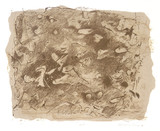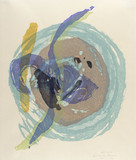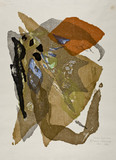Takahashi Rikio (高橋力雄 1917-1999) was one of the last true sôsaku hanga (creative prints: 創作版画) artists. He explored, through abstraction, the forms, textures, and colors found in gardens and nature. especially the classic gardens of Kyoto. Much of Takahashi's work is lyrical in mood (some of his print titles include English words such as "lyric" or "nostalgia"), although there is a greater variety of expression in Takahashi's oeuvre than perhaps some have realized. Certainly there are works of assertive gestural power that express forces in nature other than tranquility.
Takahashi, born in Honjo Wakamiyacho, Tokyo, was the son of Takahashi Tarao, an artist of the Nihonga school (Japanese-style painting: 日本画). Essentially self-taught as a printmaker, from about 1949 Rikio developed some of his skills as an unofficial disciple of the seminal figure in modern Japanese printmaking, Onchi Kôshirô (1891-1955), whose late non-representational style had a significant influence on Takahashi. He always considered Onchi as his only mentor, with their last meeting taking place in 1952. Otherwise, seven years after Onchi's death, Takahashi studied at the former Chouinard Art Institute in the Westlake district of Los Angeles in 1962-1963. The school had just been integrated into the California Institute of Arts (now in Santa Clarita) in 1961 although it retained its name until its relocation in 1970. Takahashi returned to the United States two years later to work with Ken Tyler at the Gemini G.E.L. print studio in Los Angeles (established in 1965). All told, Takahashi made four trips to the U.S. where he had 18 solo shows.
In 1958, Takahashi had his first solo show at the Yoseido Gallery in Ginza, Tokyo. Recalling that time, he said, "I put a Japanese aesthetic sense, which I had previously suppressed, into the work I showed on this occasion. This sensibility was nourished by several visits I made to Ise, Nara, and Kyoto during the period of spiritual emptiness that followed the war. Trees ruffled by the breeze, ponds and rocks, the sound of water — these were the things that had restored my spirit, and I made a deliberate attempt to capture them in my art." - akahashi's technique was representative of various experimental approaches toward printmaking adopted by the postwar sôsaku hanga artists. Using shina-faced (veneer) plywood, Takahashi would partially overlap blocks and print with thin watercolor ink, creating distinct tones.
BIBLIOGRAPHY
Jenkins, Donald: Images of a Changing World: Japanese Prints of the Twentieth Century. Portland, 1983, pp. 102 and 126.
Masayoshi Homma: "The World of Rikio Takahashi — The Spirit of Wood," in: Rikio Takahashi, The Woodblock Prints. Abe Publishing, 1998, pp. 18-21.
Smith, Lawrence: The Japanese Print Since 1900: Old Dreams and New Visions. London, 1983, pp. 119 and 129.
Smith, Lawrence: Modern Japanese Prints 1912-1989. London, 1994, p. 46.
Statler, Oliver: Modern Japanese Prints: An Art Reborn. Rutland, VT: 1956, pp. 133-136.
Takahashi Rikio: "Reflections on the Path of Printmaking," in: Rikio Takahashi, The Woodblock Prints. Abe Publishing, 1998, p. 197.
John Fiorillo: https://www.viewingjapaneseprints.net/texts/sosaku_hanga/takahashi_rikio...






